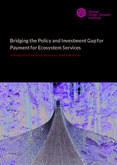Mostrar el registro sencillo del ítem
Bridging the Policy and Investment Gap for Payment for Ecosystem Services: Learning from Costa Rican Experience and Roads Ahead
| dc.contributor.author | Kim, Juhern | |
| dc.contributor.author | Madrigal, Roger | |
| dc.contributor.author | Alpízar, Francisco | |
| dc.contributor.author | Rojas Fernandez, Silvia | |
| dc.contributor.author | Global Green Growth Institute | |
| dc.date.accessioned | 2020-08-31T20:54:22Z | |
| dc.date.available | 2020-08-31T20:54:22Z | |
| dc.date.issued | 2016-10 | |
| dc.identifier.uri | https://repositorio.catie.ac.cr/handle/11554/9555 | |
| dc.description.abstract | Between 2000 to 2010, forests were lost at an average of 5.2 million hectares per year across the globe (FAO 2010). Though the drivers of deforestation and forest degradation vary, agricultural expansion is responsible for an estimated 80% of this loss (Kissinger et al. 2012). As forests are lost so are all of the knock-on economic, environmental, and social benefits of ecosystem services provided by those forests (e.g. sequestrating carbon dioxide, regulating hydrological systems, maintaining soil quality, preventing erosion, and hosting biodiversity). In fact, it is estimated that land-use change (mostly deforestation and forest degradation in the tropics) accounts for approximately 20% of annual greenhouse gas (GHG) emissions when reforestation and afforestation are excluded (Houghton 2013), or about 11% of global emissions when they are included (Searchinger et al. 2013).1 This is a common occurrence especially in developing countries with high rates of population growth, where land is intertwined with livelihood and governments are forced to make tough choices between competing land uses. Within this context, payment for ecosystem services (PES) is a powerful tool for enhancing economic, environmental, and social returns from investments in integrated ecosystem management, including forest regeneration, agricultural landscapes, agroforestry, silvo-pastoral systems, etc. It provides financial incentives for ecosystem services that are not usually monetized and paid for in the traditional market. PES schemes internalize externalities by creating new marketplaces for ecosystem services. These schemes provide a new source of income for land management, restoration, conservation, and sustainable agricultural activities. However, implementing and sustaining PES schemes over time is not a simple task. | es_ES |
| dc.language.iso | en | es_ES |
| dc.publisher | Global Green Growth Institute, Seúl (Corea del Sur) | es_ES |
| dc.rights | info:eu-repo/semantics/openAccess | es_ES |
| dc.subject | SERVICIOS DE LOS ECOSISTEMAS | es_ES |
| dc.subject | SERVICIOS AMBIENTALES | es_ES |
| dc.subject | ANALISIS | es_ES |
| dc.subject | DESARROLLO SOSTENIBLE | es_ES |
| dc.subject | FINANCIAMIENTO | es_ES |
| dc.subject | INNOVACIONES | es_ES |
| dc.subject | INVERSIONES | es_ES |
| dc.subject | CAPITAL NATURAL | es_ES |
| dc.subject | DESARROLLO | es_ES |
| dc.subject | COSTA RICA | es_ES |
| dc.title | Bridging the Policy and Investment Gap for Payment for Ecosystem Services: Learning from Costa Rican Experience and Roads Ahead | es_ES |
| dc.type | Reporte técnico | es_ES |
Ficheros en el ítem
Este ítem aparece en la(s) siguiente(s) colección(ones)
-
Publicaciones y documentos [4428]


